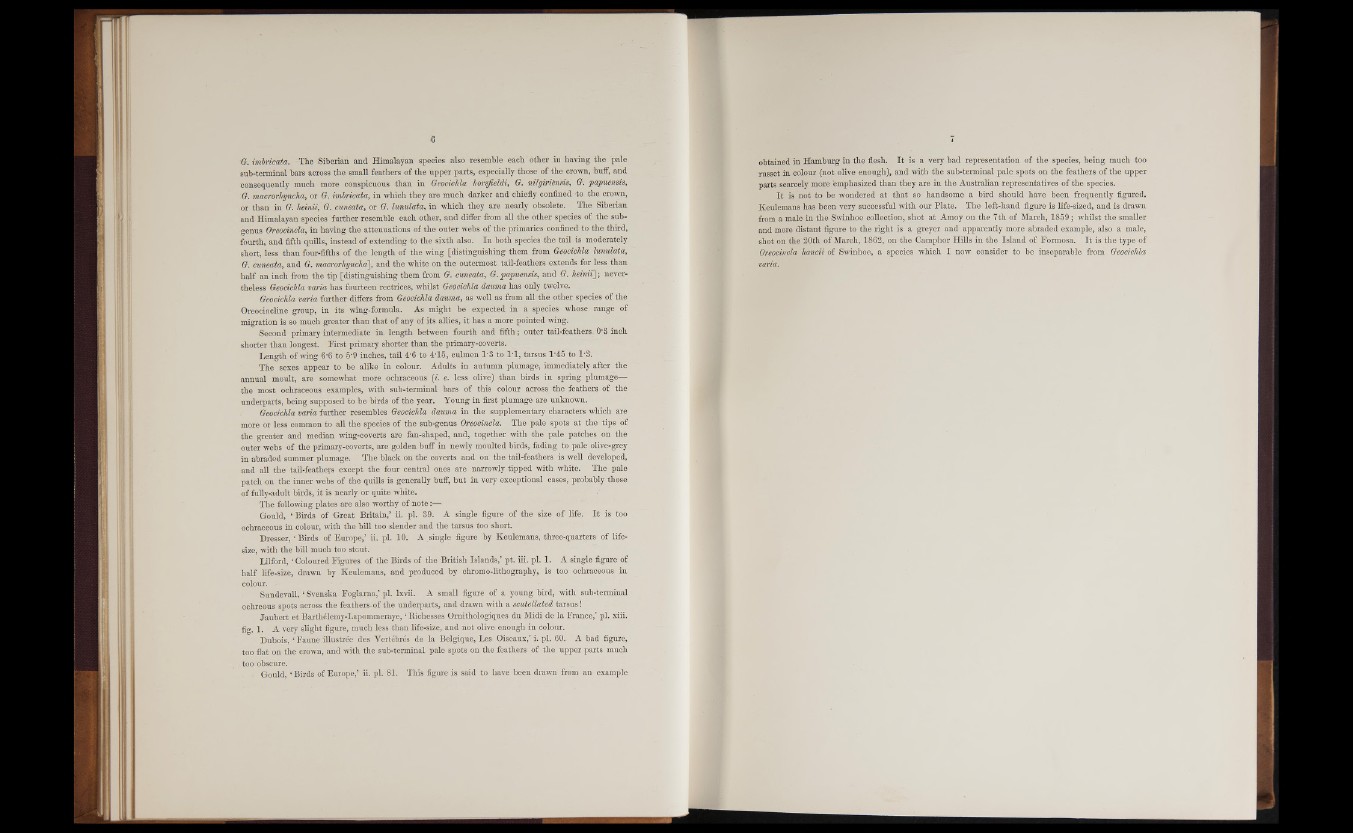
G. imlricata. -The Siberian and Himalayan species also resemble each other in haying the pale
sub-terminal bars across the small feathers of the upper parts, especially those of the crown, buff, and
consequently much more conspicuous than in Geodchla horsfieldi, G. nilyiriënris, G. papuensis,
G. macrorbyncha, or G. imlricata, in which they are much darker and chiefly confined 'to the crown,
or than in G. beinii, G. cmeata, or G. lunulata, in which they are nearly obsolete. The Siberian
and Himalayan species farther resemble each other, and differ from all the other species of the subgenus
Oreocincla, in having the attenuations of the outer webs of the primaries confined to the third,
fourth, and fifth quills, instead of extending to the sixth also. In both species the tail is moderately
short, less than four-fifths of the length of the wing [.distinguishing them from Geodchla lunulata,
G. cuneata, and G. macrorbyncha'], and the white on the outermost tail-feathers extends for less than
half an inch from the tip [distinguishing them from G. cuneata, G.papuensis, and G. beinii] ; nevertheless
Geodchla varia has fourteen rectrices, whilst Geodchla dauma has only twelve.
Geodchla varia further differs from Geodchla dauma, as well as from all the other species of the
Oreoeindine group, in its wing-formula. As might be expected in a species whose range of
migration is so much greater than that of any of its allies, it has a more pointed wing.
Second primary intermediate in- length between fourth and fifth; outer tail-feathers. 0'3 inch
shorter than longest. First primary shorter than the primaty-covertS.
Length of wing 6'6 to 5'9 inches, tail 4’6 to 4-15, cnlmen 1-3 to IT, tarsus T46 to T3.
The sexes appear to be alike in colour. Adults in autumn plumage, immediately after the
annual moult, are somewhat more ochraceous (*. ». less olivefrthan birds in spring plumage—
the most ochraceous examples, with sub-terminal bars of this colour across the feathers of thé
underparts, being supposed to be birds of the year. Young in first plumage are unknown.
Geodchla varia further resembles Geodchla dauma in the supplementary characters which are
more or less common to all the species of the suh-genus Oreocincla. The pale spots at the tips of
the greater and median wing-coverts are fan-shaped, and, together with the pale patches on the
outer webs of the primary-coverts, are golden buff in newly moulted birds, fading to pale olive-grey
in abraded summer plumage. The black on the coverts and on the tail-feathers is well developed,
and all the tail-feathers except the four central ones are narrowly tipped with white. The pale
patch on the inner webs of the quills is generally huff, but in very exceptional cases, probably those
of fully-adult birds, it is nearly or quite white.
The following plates are also worthy of note :—
Gould, ‘ Birds of Great Britain,’ ii. pi. 39. A single figure of the size of life. It is too
ochraceous in colour, with the bill too slender and the tarsus too short.
Dresser, ‘ Birds of Europe,’ ii. pi. 10. A single figure by Keulemans, three-quarters of life-
size, with the bill much too stout.
Lilford, ‘ Coloured Figures of the Birds of the British Islands,’ pt. iii. pl. 1. A single figure of
half life-size, drawn by Keulemans, and produced by chromo-lithography, is too ochraceous in
colour. ■
Sundevall, ‘ Svenska - Foglama,’ pi. lxvii. A small, figure of a young bird, with sub-terminal
ochxeous spots across the feathers, of the underparts, and drawn with a scutellated tarsus!
Jaubert et Barthé.lemy-Lapommeraye, ‘ Richesses Ornithologiques du Midi de la France,’ pl. xiii.
fi». 1. A very slight figure, much less than life-size, and hot olive enough in colour.
Dubois, ‘ Faune illustrée des Vertébrés de la Belgique, Les Oiseaux,’ i. pl, 60. A bad figure,
too flat on the crown, and with the sub-terminal pale spots on the feathers of the upper parts much
; too obscure.
, Gould, ‘Birds of Europe,’ ii. pl. 81. This figure is said to have been drawn from an example
obtained in Hamburg in the flesh. It is a very bad representation of the species, being much too
russet in colour (not olive enough), and with the sub-terminal pale spots on the feathers of the upper
parts scarcely more 'emphasized than they are in the Australian representatives of the species.
It is not to be wondered at that so handsome a bird should have been frequently figured.
Keulemans has been very successful with our Plate. The left-hand figure is life-sized, and is drawn
from a male in the Swinhoe collection, shot at Amoy on the 7th of March, 1859; whilst the smaller
and more distant figure to the right is a greyer and apparently more abraded example, also a male,
shot on the 20th of March, 1862, on the Camphor Hills in the Island of Formosa. It is the type of
Oreodncla handi of Swinhoe, a species which I now consider to be inseparable from Geodchla
varia.